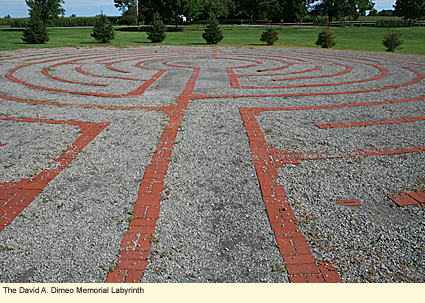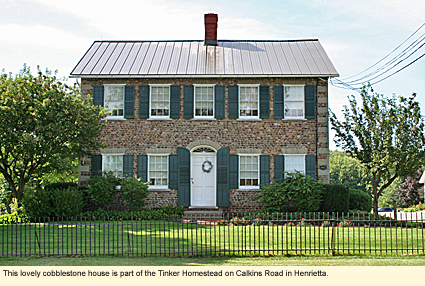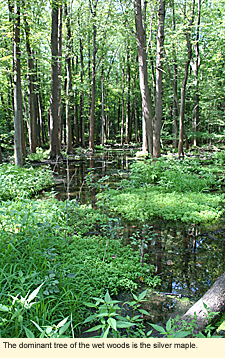Home > Recreation > Nature CentersNature Centers in the Finger LakesHansen Nature Center/Tinker Nature Park1525 Calkins Rd. Henrietta, NY 14467 585-359-7044
LOCATIONTinker Nature Park, the Hansen Nature Center, and the Tinker Homestead Museum are located in the Town of Henrietta in Monroe County. GENERALTinker Nature Park is a well-maintained town park, occupying 68 acres of field, woodland, marsh, and pond. It offers a perimeter trail and two short nature trails, a wildlife observation blind, picnic tables and pavilions, a playground, an herb garden, a cobblestone house, which acts as a museum, a labyrinth, and an interpretative center.
INTERPRETATIVE CENTERThe Hansen Nature Center--named for Henry Hansen, who provided the funds for the construction of the log building--has classrooms, numerous displays, and restrooms. It is here that you should stop first when arriving at the park, as the center has brochures and check lists (herbaceous plants, woody plants, macro pond organisms, fungi and mosses, birds, and non-bird animals). The check lists are great resources beause they can give you an idea of what plants and animals you are likely to see on the property. There is also an illustrated guide to the woody plants of the park to help you identify the plants you find. Sometimes, but not always, the center has park maps (pdf). (There are no maps of the park posted in the park. Make sure to bring a copy of the map with you if you can.)
Most nature centers have displays of stuffed animals. Hansen does, too. However, rather than just showing a stuffed animal, Hansen's displays show the animals in typical habitat, doing something they would normally be doing in the wild. Most of Hansen's displays show considerable thought and, consequently, are a bit more interesting than you usually find at nature centers. And, like Beaver Lake Nature Center, Hansen has an indoor, viewable working bee hive. TRAILSThe park has three main trails--the perimeter trail, the pond boardwalk, and the nature trail.
The boardwalk is about .1 mi./.2 km. long and passes through a cattail wetland that changes into another section of wet woods. Benches along the boardwalk allow visitor's to stop and enjoy the area.
The nature trail is a path covered in bark chips through a drier section of the woods. There are numerous stations where visitors can stop and read an interesting fact about nature and then open a box to find an example--a turtle shell, the cast of a deer's hoof print, etc. Children need to be accompanied by adults on this section as the interpretative signs are quite tall and may even be too high up for short adults. BIKINGAll of the 1.2 mi./2 km. perimeter trail is bike-able. Most of the surface is crushed limestone, but the part through the woods is raised bark
Calkins Road is a well-paved road with a good shoulder. This is a fairly busy residential road. Helmets are recommended for this section. BOATINGKayaking and canoeing are permitted on the wetland pond, however this is a very small area of perhaps .5 acre. LABYRINTHTinker Nature Park is the only nature center in the Finger lakes with a labyrinth. This is a large Chartre-style labyrinth made of red brick and crushed limestone. It is located to the east of the cobblestone house.
MUSEUMThe lovely cobblestone house that originally belonged to James and Rebecca Tinker and their six children and the large barn to the right of the house are open to the public on a request basis only. If you know you are coming to the park and would like to visit the house and barn, call the nature center before coming to make arrangements for a tour. There is no charge for the tour. |
|
|


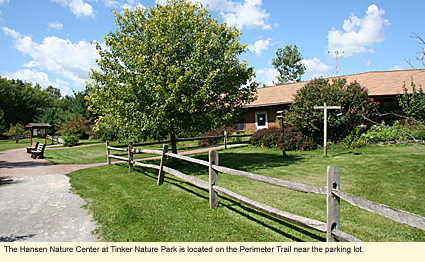
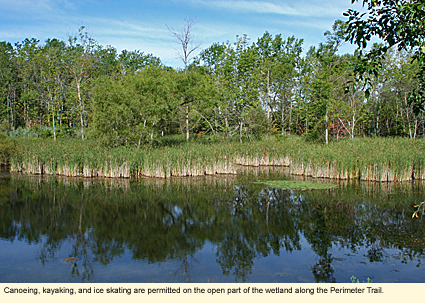
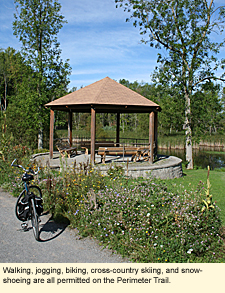 The perimeter trail is 1.2 mi./2 km. long with exercise stations in the open area. It leads through a dense, wet woods. This section of the trail--the dense, wet woods--is unique to nature centers in the Finger Lakes. The dominant tree is the silver maple (
The perimeter trail is 1.2 mi./2 km. long with exercise stations in the open area. It leads through a dense, wet woods. This section of the trail--the dense, wet woods--is unique to nature centers in the Finger Lakes. The dominant tree is the silver maple (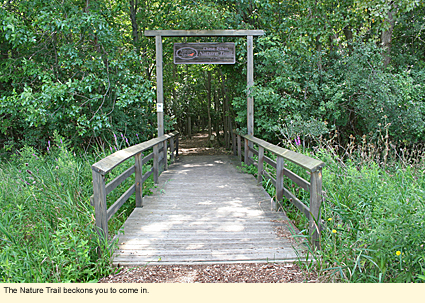
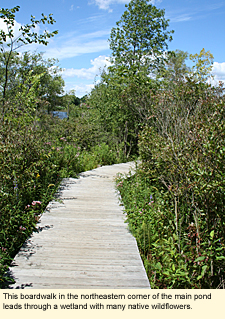 chips. The entire route is interesting and fun to ride--more than once. This is the only nature center in the Finger Lakes that allows bikes in its wooded area.
chips. The entire route is interesting and fun to ride--more than once. This is the only nature center in the Finger Lakes that allows bikes in its wooded area.